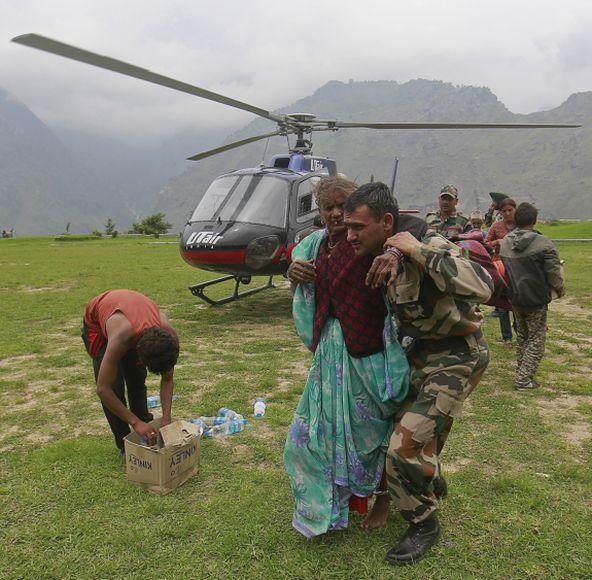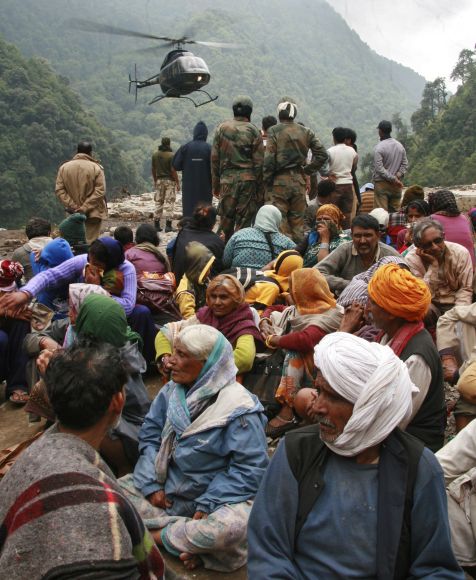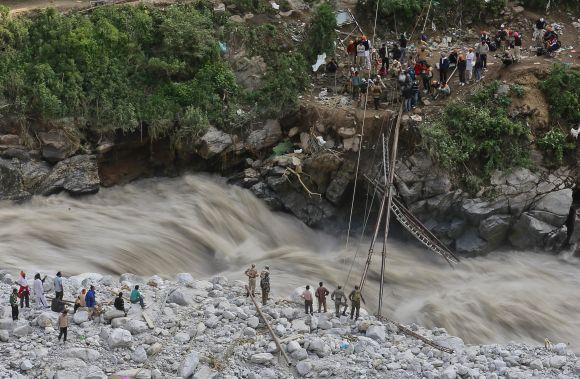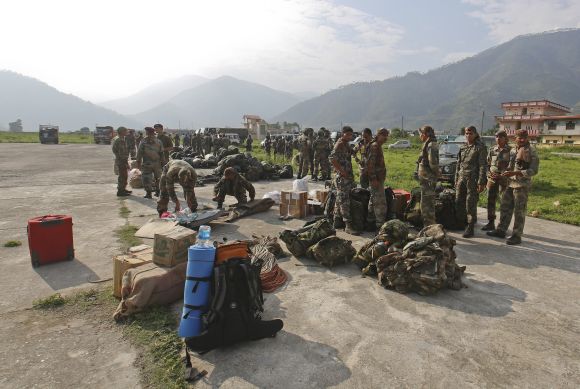 | « Back to article | Print this article |
When disaster strikes: Govts may fail, but not our military
The military’s earthquake relief operations in Gujarat, Kashmir and Sikkim, and rescue work during the Ladakh flash floods highlight that it is the only effective disaster response force in the country, says Ajai Shukla
The Indian Air Force has imaginatively employed its new C-130J Super Hercules aircraft -- six of which were purchased in 2010 from the United States for Rs 3,835 crore -- to revive flagging rescue and relief efforts at Dharasu, in flood-hit Uttarakhand.
With fuel running out for the Indian Air Force’s Mi-17 helicopters that were flying relief missions from the small, 1,300-metre Dharasu airstrip, the C-130Js’ game-changing ability to land on tiny airstrips was brought into play. Fully fuelled C-130Js flew in from Hindon (near Ghaziabad) and landed in Dharasu, each one unloading 8,000 litres of aviation fuel from its on-board tanks for use by the Mi-17s. On their return journey, the C-130Js ferried medically distressed people, making this a two-way air bridge.
This is just one recent example of military equipment and personnel becoming the instrument of last resort for overwhelmed administrators in disaster situations.
The Gujarat earthquake in 2001; the Kashmir earthquake in 2005; the Ladakh flash floods in 2010; the Sikkim earthquake in 2011; and multiple flood relief operations highlight that the military is the only effective disaster response force in the country. And that the vast sums spent on the military and its equipment are not just insurance for some far-fetched threat of external aggression but real capability for situations that all too frequently move beyond the capacity of the other instruments of state.
Click NEXT to read further...
Military's role in stark contrast to the ineptitude of local administrations
Every one of India’s military units has an official plan for “Aid to Civil Authorities” that is as carefully formulated as its plans for war. This spells out exactly what that unit will do when the government asks for help during flood, earthquake or breakdown of public order. When officially requisitioned by what the army still cheerfully calls “the civil administration”, all its equipment is deployed to assist the people.
India’s armed forces have proved equally useful during transnational natural disasters, such as the Indian Ocean tsunami of 2004. The Indian Navy put 30 vessels to sea in just 48 hours, providing desperately needed relief in coastal India, and across the region including Sri Lanka and Indonesia. So quick and effective was the navy’s response that the US Pacific Command, which arrived later, openly acknowledged for the first time that the Indian Navy was the only regional force with the resources and will to exercise power across the Indian Ocean.
This careful planning and ability contrasts starkly with the bumbling ineptitude of local administrations, state disaster response forces and the National Disaster Management Authority, which wags say is a full-fledged disaster itself. If the Uttarakhand government seems overwhelmed, the reason -- as is evident from the April 23 audit report by the Comptroller and Auditor General of the Uttarakhand Disaster Management Authority -- is that the state has utterly failed to prepare for natural disasters. The Uttarakhand Disaster Management Authority, created in 2007, has never held a meeting; almost half the posts in the district emergency cells remain unfilled to this day.
Click NEXT to read further...
'No Indian state meets the norms of disaster management'
A fatalistic Uttarakhand Chief Minister, Vijay Bahuguna, told CNN-IBN’s Karan Thapar in an interview that there could be no actionable programme for the plethora of disasters -- cloudbursts, glacier collapses and flooded rivers -- that Uttarakhand might face. In his defence, he argued that no Indian state meets the norms of disaster management. This is factually true, but logically irrelevant.
Trying to show up Bahuguna, Gujarat’s chief minister arrived in Uttarakhand, putting together a surreal cameo performance entitled, “No Gujarati Left Behind” (I made up the title, but the rest is true). Ignoring the responses of other agencies, Narendra Modi and his crack team brainstormed till the wee hours, and then dispatched (according to one Times of India report, at least) 80 Toyota Innovas, four Boeings and a fleet of luxury buses to pluck a claimed 15,000 stranded Gujaratis from the sliding mud and swirling waters of Uttarakhand and transport them to safety. But while Modi may rescue Gujaratis in an election year (why? I thought he was projecting himself as the leader of all Indians?), the rest of the citizenry must rely on the armed forces.
True, India’s geography makes it essential for the military to play this role. It is equally true that even countries with functional governments call upon their militaries when situations legitimately escalate: remember Hurricane Katrina and New Orleans? But few countries do so as often as India, except perhaps Pakistan -- and we know what that has led to. It must also be noted that the remoteness and vulnerability of so much of this otherwise teeming country are unquestionably the failure of the Indian state. When things go bad -- whether in terms of security or natural disasters -- there is always the military!
Click NEXT to read further...
'The military must be nurtured as an important wing of govt'
To remember what we often forget, the military must be nurtured as an important wing of government, our last recourse in dire need. The cold-eyed mandarins in New Delhi must commit the resources and attention that this instrument needs, remembering that this is not “non-productive expenditure”, but a living organisation that must be continually replenished.
Tailpiece: I remember, during the 2002 J&K elections, which are widely regarded as a turning point for that troubled state, a 20-minute sortie that I flew in an Indian Air Force Mi-17 helicopter, which was conveying a polling team and an electronic voting machine from Doda to an isolated village high in the Pir Panjal. This was done so that 11 voters in that village could cast their ballots. On the evening of polling day, the Mi-17 went back to pick up the polling team. More than any flowery statements on India’s democracy, this astonishing military effort to determine the democratic choice of 11 voters represents for me the triumph of India’s electoral exercise.




